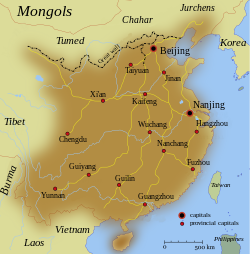Ming Chinese
| Great Ming | ||||||||||
| 大明 | ||||||||||
|
||||||||||
|
Ming China around 1580
|
||||||||||
| Capital |
Nanjing (Yingtian prefecture) (1368–1644) Beijing (Shuntian prefecture) (1403–1644) |
|||||||||
| Languages | Official language: Mandarin Other Chinese languages Other languages: Turki (Modern Uyghur), Old Uyghur language, Tibetan, Mongolian, Jurchen, others |
|||||||||
| Religion | Heaven worship, Taoism, Confucianism, Buddhism, Chinese folk religion, Islam, Roman Catholicism | |||||||||
| Government | Absolute monarchy | |||||||||
| Emperor () | ||||||||||
| • | 1368–1398 | Hongwu Emperor | ||||||||
| • | 1627–1644 | Chongzhen Emperor | ||||||||
| Senior Grand Secretary | ||||||||||
| • | 1402–1407 | Xie Jin | ||||||||
| • | 1644 | Wei Zaode | ||||||||
| History | ||||||||||
| • | Established in Nanjing | 23 January 1368 | ||||||||
| • | Beijing designated as capital | 28 October 1420 | ||||||||
| • | Fall of Beijing | 25 April 1644 | ||||||||
| • | End of the Southern Ming | 1683 | ||||||||
| Area | ||||||||||
| • | 1415 | 6,500,000 km² (2,509,664 sq mi) | ||||||||
| Population | ||||||||||
| • | 1393 est. | 65,000,000 | ||||||||
| • | 1403 est. | 66,598,337¹ | ||||||||
| • | 1500 est. | 125,000,000² | ||||||||
| • | 1600 est. | 160,000,000³ | ||||||||
| Currency |
Paper money (1368–1450) Bimetallic: copper cashes (文, wén) in strings of coin and paper Silver taels (兩, liǎng) in sycees and by weight |
|||||||||
|
||||||||||
| Today part of | ||||||||||
| Remnants of the Ming dynasty ruled southern China until 1662, and Taiwan until 1683 a dynastic period which is known as the Southern Ming. ¹The numbers are based on estimates made by CJ Peers in Late Imperial Chinese Armies: 1520–1840 ²According to A. G. Frank, ReOrient: global economy in the Asian Age, 1998, p. 109 ³According to A. Maddison, The World Economy Volume 1: A Millennial Perspective Volume 2, 2007, p. 238 |
||||||||||
| Ming Dynasty | |||||||||||||||||||||||||||

"Ming dynasty" in Chinese characters
|
|||||||||||||||||||||||||||
| Chinese | 明朝 | ||||||||||||||||||||||||||
|---|---|---|---|---|---|---|---|---|---|---|---|---|---|---|---|---|---|---|---|---|---|---|---|---|---|---|---|
|
|||||||||||||||||||||||||||
| Great Ming | |||||||||||||||||||||||||||
| Chinese | 大明 | ||||||||||||||||||||||||||
|
|||||||||||||||||||||||||||
| Empire of the Great Ming | |||||||||||||||||||||||||||
| Traditional Chinese | 大明帝國 | ||||||||||||||||||||||||||
| Simplified Chinese | 大明帝国 | ||||||||||||||||||||||||||
|
|||||||||||||||||||||||||||
| Transcriptions | |
|---|---|
| Standard Mandarin | |
| Hanyu Pinyin | Míng cháo |
| Wade–Giles | Ming2 ch'ao2 |
| IPA | [mǐŋ ʈʂʰǎu] |
| Wu | |
| Suzhounese | Mín záu |
| Yue: Cantonese | |
| Yale Romanization | Ming4 chiu4 |
| IPA | [mȅŋ tsʰȉːu̯] |
| Jyutping | Ming4 ciu4 |
| Southern Min | |
| Tâi-lô | Bîng tiâu |
| Transcriptions | |
|---|---|
| Standard Mandarin | |
| Hanyu Pinyin | Dà Míng |
| Yue: Cantonese | |
| Yale Romanization | Daai6 Ming4 |
| IPA | [tàːi̯ mȅŋ] |
| Transcriptions | |
|---|---|
| Standard Mandarin | |
| Hanyu Pinyin | Dà Míng Dì Guó |
| Wade–Giles | Ta Ming Ti Kuo |
| Wu | |
| Romanization | da men di kueh/koh |
| Yue: Cantonese | |
| Yale Romanization | Daai6 Ming4 Dai3 Gwok3 |
| IPA | [tàːi̯ mȅŋ tɐ̄i̯ kʷɔ̄ːk̚] |
| Jyutping | daai6 ming4 dai3 gwok3 |
The Ming dynasty was the ruling dynasty of China – then known as the Empire of the Great Ming – for 276 years (1368–1644) following the collapse of the Mongol-led Yuan dynasty. The Ming, described by some as "one of the greatest eras of orderly government and social stability in human history," was the last imperial dynasty in China ruled by ethnic Han Chinese. Although the primary capital of Beijing fell in 1644 to a rebellion led by Li Zicheng (who established the Shun dynasty, soon replaced by the Manchu-led Qing dynasty), regimes loyal to the Ming throne – collectively called the Southern Ming – survived until 1683.
The Hongwu Emperor (ruled 1368–98) attempted to create a society of self-sufficient rural communities ordered in a rigid, immobile system that would guarantee and support a permanent class of soldiers for his dynasty: the empire's standing army exceeded one million troops and the navy's dockyards in Nanjing were the largest in the world. He also took great care breaking the power of the court eunuchs and unrelated magnates, enfeoffing his many sons throughout China and attempting to guide these princes through the Huang Ming Zu Xun, a set of published dynastic instructions. This failed spectacularly when his teenage successor, the Jianwen Emperor, attempted to curtail his uncles' power, prompting the Jingnan Campaign, an uprising that placed the Prince of Yan upon the throne as the Yongle Emperor in 1402. The Yongle Emperor established Yan as a secondary capital and renamed it Beijing, constructed the Forbidden City, and restored the Grand Canal and the primacy of the imperial examinations in official appointments. He rewarded his eunuch supporters and employed them as a counterweight against the Confucian scholar-bureaucrats. One, Zheng He, led seven enormous voyages of exploration into the Indian Ocean as far as Arabia and the eastern coasts of Africa.
...
Wikipedia

